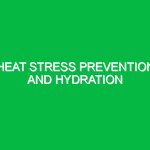As winter approaches, the harsh realities of cold stress become a pressing concern, especially in workplaces where personnel may be exposed to extreme temperatures. Cold stress refers to the physical and mental strain that occurs when the body loses heat faster than it can produce it. This article aims to illuminate the signs, risks, and preventive measures associated with cold stress, specifically focusing on hypothermia and frostbite. By understanding these conditions, we can better protect ourselves and our colleagues in the Health, Safety, and Environment (HSE) realm.
Understanding Cold Stress and Its Relevance in HSE
Cold stress is not just a term; it’s a significant risk factor that can lead to serious health complications. Hypothermia occurs when the body temperature drops below 95°F (35°C), impacting the body’s ability to function normally. Conversely, frostbite entails the freezing of skin and underlying tissues, often affecting extremities like fingers and toes. Both conditions can have dire consequences if not recognized and treated promptly.
In the context of HSE, addressing cold stress is crucial. Workers in sectors such as construction, mining, and emergency services often work in environments where cold exposure is a risk. Protecting these individuals is not just a regulatory requirement; it’s a moral obligation. We owe it to our teams to ensure that they are informed, equipped, and prepared to face the cold.
Identifying Hazards and Risks Associated with Cold Stress
Cold stress is multifaceted, and understanding its risks involves examining various factors. Here are some critical hazards associated with cold stress:
1. Environmental Conditions
Extreme weather conditions, such as sub-zero temperatures, wind chill, and wetness, exacerbate the risk of cold stress. Wind chill can significantly lower the perceived temperature, increasing the likelihood of hypothermia and frostbite. For instance, a temperature of 30°F (-1°C) with a wind speed of 20 mph can feel like 16°F (-9°C). This effect can be particularly hazardous for workers who must remain outdoors for extended periods.
2. Inadequate Clothing
Improper clothing can lead to rapid heat loss. For example, wearing cotton can trap moisture against the skin, reducing insulation and increasing the risk of hypothermia. Workers should be educated on the importance of layering and choosing materials that wick moisture away from the body.
3. Physical Exhaustion
Fatigue can impair judgment and decrease physical performance, making individuals more susceptible to cold stress. When workers are tired, they may not recognize the early signs of hypothermia or frostbite, increasing the risk of severe complications.
4. Lack of Awareness and Training
Sometimes, the biggest hazard is ignorance. Many workers may not recognize the signs of cold stress or understand the associated risks. Regular training sessions can be instrumental in fostering awareness and promoting safety practices.
Safety Precautions and Best Practices
To effectively combat cold stress, implementing safety precautions is essential. Here are some actionable strategies:
1. Appropriate Clothing
Encouraging the use of layered clothing is vital. The first layer should be moisture-wicking, the middle layer should provide insulation, and the outer layer should be windproof and waterproof. It’s crucial that clothing fits well and allows for movement without restriction.
2. Regular Breaks
Implementing scheduled breaks in a warm environment can help mitigate the effects of cold exposure. Workers should be encouraged to take breaks before they start feeling cold, thus preventing the onset of more severe symptoms.
3. Hydration and Nutrition
Maintaining hydration and proper nutrition is essential for sustaining energy levels and body heat. Hot beverages can be particularly effective, as they not only hydrate but also provide warmth.
4. Awareness and Training
Regular training sessions should focus on recognizing the symptoms of hypothermia and frostbite. For example, a company could host workshops where employees are taught to identify the warning signs such as shivering, confusion, and pale skin. Role-playing scenarios can enhance learning and retention.
5. Monitoring and Buddy Systems
Establishing a buddy system can help ensure that workers keep an eye on each other. Regular check-ins can facilitate early recognition of cold stress symptoms. Moreover, utilizing monitoring technology can help track the health of workers in extreme conditions.
Regulations and Standards Governing Cold Stress
Several regulations and standards address cold stress in the workplace. The Occupational Safety and Health Administration (OSHA) emphasizes the importance of providing a safe work environment that includes protection against extreme temperatures. While OSHA does not have a specific standard for cold stress, it does require employers to assess workplace hazards and implement necessary training and protective measures.
Additionally, the American National Standards Institute (ANSI) provides guidelines for managing cold stress. These guidelines help organizations develop effective safety programs that include risk assessments, training, and emergency response protocols.
Conclusion
Cold stress is a serious concern that demands our attention, particularly in industries where workers face harsh winter conditions. By recognizing the signs of hypothermia and frostbite and understanding the associated risks, we can take proactive steps to protect ourselves and our colleagues. Implementing best practices such as proper clothing, regular breaks, and ongoing training can make a significant difference in ensuring safety. In an environment where the stakes are high, awareness and preparation are key to overcoming the challenges posed by cold stress.
As someone who has worked in outdoor environments during winter, I can attest to the importance of these practices. One particularly frigid day, I witnessed a colleague who ignored early signs of frostbite on his fingers. It was a sobering reminder of how easily cold stress can escalate into a serious health issue. Let’s take these lessons to heart and prioritize the well-being of ourselves and our teams. Together, we can combat cold stress effectively and create a safer work environment for all.


